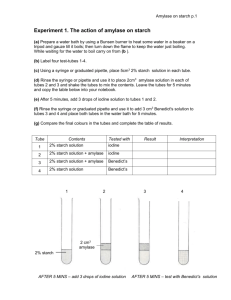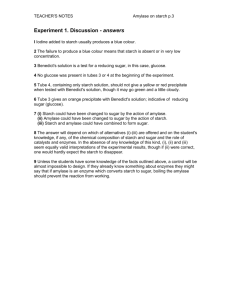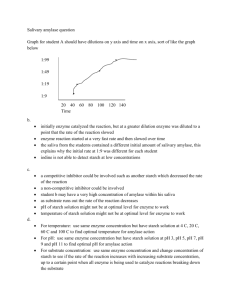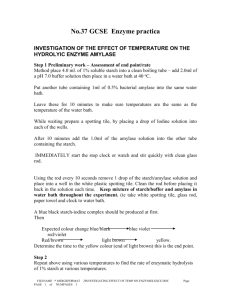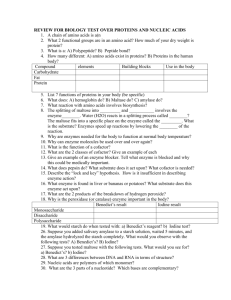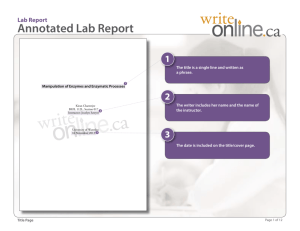Discussion - WriteOnline.ca
advertisement
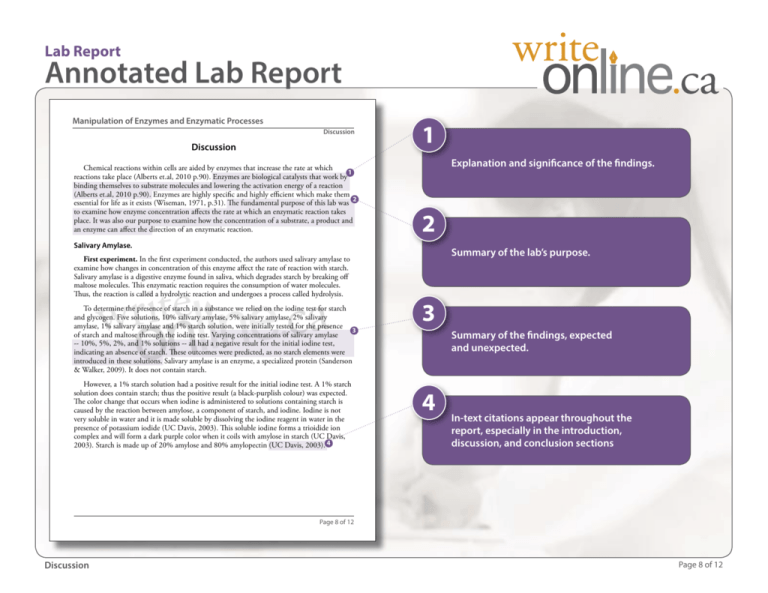
Lab Report . Annotated Lab Report Manipulation of Enzymes and Enzymatic Processes Discussion Discussion Chemical reactions within cells are aided by enzymes that increase the rate at which 1 reactions take place (Alberts et.al, 2010 p.90). Enzymes are biological catalysts that work by binding themselves to substrate molecules and lowering the activation energy of a reaction (Alberts et.al, 2010 p.90). Enzymes are highly specific and highly efficient which make them 2 essential for life as it exists (Wiseman, 1971, p.31). The fundamental purpose of this lab was to examine how enzyme concentration affects the rate at which an enzymatic reaction takes place. It was also our purpose to examine how the concentration of a substrate, a product and an enzyme can affect the direction of an enzymatic reaction. 1 Explanation and significance of the findings. 2 Salivary Amylase. First experiment. In the first experiment conducted, the authors used salivary amylase to examine how changes in concentration of this enzyme affect the rate of reaction with starch. Salivary amylase is a digestive enzyme found in saliva, which degrades starch by breaking off maltose molecules. This enzymatic reaction requires the consumption of water molecules. Thus, the reaction is called a hydrolytic reaction and undergoes a process called hydrolysis. . To determine the presence of starch in a substance we relied on the iodine test for starch and glycogen. Five solutions, 10% salivary amylase, 5% salivary amylase, 2% salivary amylase, 1% salivary amylase and 1% starch solution, were initially tested for the presence 3 of starch and maltose through the iodine test. Varying concentrations of salivary amylase -- 10%, 5%, 2%, and 1% solutions -- all had a negative result for the initial iodine test, indicating an absence of starch. These outcomes were predicted, as no starch elements were introduced in these solutions. Salivary amylase is an enzyme, a specialized protein (Sanderson & Walker, 2009). It does not contain starch. However, a 1% starch solution had a positive result for the initial iodine test. A 1% starch solution does contain starch; thus the positive result (a black-purplish colour) was expected. The color change that occurs when iodine is administered to solutions containing starch is caused by the reaction between amylose, a component of starch, and iodine. Iodine is not very soluble in water and it is made soluble by dissolving the iodine reagent in water in the presence of potassium iodide (UC Davis, 2003). This soluble iodine forms a trioidide ion complex and will form a dark purple color when it coils with amylose in starch (UC Davis, 2003). Starch is made up of 20% amylose and 80% amylopectin (UC Davis, 2003). 4 Summary of the lab’s purpose. 3 Summary of the findings, expected and unexpected. 4 In-text citations appear throughout the report, especially in the introduction, discussion, and conclusion sections Page 8 of 12 Discussion Page 8 of 12 Lab Report . Annotated Lab Report Manipulation of Enzymes and Enzymatic Processes Discussion Second experiment. In a second control experiment, the authors used Benedict’s test to determine the presence of reducing sugars in a solution of salivary amylase. (Kumar, 2007). The presence of reducing sugars would indicate the completion of the enzymatic reaction with starch. The authors added 4ml of Benedict’s solution to four test tubes containing only varying concentrations of salivary amylase in water -- 10%, 5%, 2%, and 1% solutions, respectively. Similar to the iodine test, a fifth test tube contained no salivary amylase but 6 instead a 1% starch solution. The authors predicted that none of the solutions of salivary amylase would have a positive Benedict’s test because no source of reducing sugars was present in the test tube. Salivary amylase is a specialized protein, and Benedict’s solution consists of cupric sulphate, sodium citrate, and sodium carbonate (Chatterjae & Shinde, 2012). However, the 10% and 5% salivary amylase solutions did have positive results (for the 10% solution, an orange brown precipitate formed, and a green-brown precipitate formed for the 5% salivary amylase solution). These results were not expected. 5 Comparison with original hypothesis and theories. 6 A discussion of weaknesses of the experiment. These positive results likely occurred because the authors used a manufactured version of the enzyme salivary amylase. This manufactured enzyme contained lactose, a reducing sugar (Kumar, 2007), in trace amounts. However, since the enzyme contained only trace amounts of lactose, only the solutions with a high concentration of salivary amylase had a positive result, indicating the presence of the sugar. Thus, the other two solutions with lesser concentrations of salivary amylase, 2% and 1%, respectively, tested negative, indicating no presence of reducing sugars. . Third experiment. To determine the effect of varying concentrations of the enzyme on the rate at which starch degrades to maltose, the authors again applied the iodine test. Varying concentrations of salivary amylase in water (to instigate hydrolysis) -- 10%, 5%, 2%, 1% -- were mixed with a 1% starch solution, and a McIlvane Buffer. The buffer was 5 added to maintain the appropriate pH for the enzymatic reaction. The authors expected that the salivary amylase would act on the starch, the substrate, to catalyze the reaction to form maltose (Sanderson & Walker, 2009). Thus, at the end of the reaction, no starch should be present. All solutions had an initial positive iodine test, as starch was present in the 1% starch solution. As time progressed, the solutions turned yellow, indicating the absence of the original starch, as expected. The solutions of starch had been hydrolyzed to maltose (Sanderson & Walker, 2009). Page 9 of 12 Discussion Page 9 of 12


